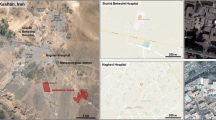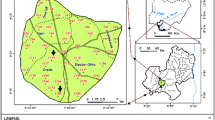Abstract
The relationship between indoor and outdoor particulate air pollution was investigated at an urban background site on the Payambar Azam Campus of Mazandaran University of Medical Sciences in Sari, Northern Iran. The concentration of particulate matter sized with a diameter less than 1 μm (PM1.0), 2.5 μm (PM2.5), and 10 μm (PM10) was evaluated at 5 outdoor and 12 indoor locations. Indoor sites included classrooms, corridors, and office sites in four university buildings. Outdoor PM concentrations were characterized at five locations around the university campus. Indoor and outdoor PM measurements (1-min resolution) were conducted in parallel during weekday mornings and afternoons. No difference found between indoor PM10 (50.1 ± 32.1 μg/m3) and outdoor PM10 concentrations (46.5 ± 26.0 μg/m3), indoor PM2.5 (22.6 ± 17.4 μg/m3) and outdoor PM2.5 concentration (22.2 ± 15.4 μg/m3), or indoor PM1.0 (14.5 ± 13.4 μg/m3) and outdoor mean PM1.0 concentrations (14.2 ± 12.3 μg/m3). Despite these similar concentrations, no correlations were found between outdoor and indoor PM levels. The present findings are not only of importance for the potential health effects of particulate air pollution on people who spend their daytime over a period of several hours in closed and confined spaces located at a university campus but also can inform regulatory about the improvement of indoor air quality, especially in developing countries.


Similar content being viewed by others
References
Adams, H. S., Nieuwenhuijsen, M. J., Colvile, R. N., McMullen, M. A. S., & Khandelwal, P. (2001). Fine particle (PM 2.5) personal exposure levels in transport microenvironments, London, UK. Science Total Environment, 279(1), 29–44.
Anu, K., Jaakko, K., Ari, K., Päivi, A., & Tarja, K. (2002). A model for evaluating the population exposure to ambient air pollution in an urban area. Atmospheric Environment, 36(13), 2109–2119.
Brook, R. D., Franklin, B., Cascio, W., Hong, Y., Howard, G., Lipsett, M., Luepker, R., Mittleman, M., Samet, J., Smith Jr., S. C., & Tager, I. (2004). Air pollution and cardiovascular disease: a statement for healthcare professionals from the expert panel on population and prevention science of the American Heart Association. Circulation, 109(21), 2655–2671.
Brunekreef, B., & Holgate, S. T. (2002). Air pollution and health. The Lancet, 360(9341), 1233–1242.
Dominici, F., Peng, R. D., Bell, M. L., Pham, L., McDermott, A., Zeger, S. L., & Samet, J. M. (2006). Fine particulate air pollution and hospital admission for cardiovascular and respiratory diseases. JAMA-Journal American Medical Association, 295(10), 1127–1134.
Gehring, U., Heinrich, J., Krämer, U., Grote, V., Hochadel, M., Sugiri, D., Kraft, M., Rauchfuss, K., Eberwein, H. G., & Wichmann, H. E. (2006). Long-term exposure to ambient air pollution and cardiopulmonary mortality in women. Epidemiology, 17(5), 545–551.
Halek, F., Kianpour-Rad, M., & Kavousirahim, A. (2013). Parametric evaluation of indoor particulate matters in elementary schools in the central parts of Tehran. Indoor and Built Environment, 22(3), 580–585.
Hassanvand, M. S., Naddafi, K., Faridi, S., Arhami, M., Nabizadeh, R., Sowlat, M. H., Zahra, P., Noushin, R., Fatemeh, M., Homa, K., Akbar, G., Shahrokh, N., Mahmood, A., Gholamreza, G., & Masud, Y. (2014). Indoor/outdoor relationships of PM10, PM2.5, and PM1 mass concentrations and their water-soluble ions in a retirement home and a school dormitory. Atmospheric Environment, 82, 375–382.
Hoek, G., Brunekreef, B., Goldbohm, S., Fischer, P., & van den Brandt, P. A. (2002). Association between mortality and indicators of traffic-related air pollution in the Netherlands: a cohort study. The Lancet, 360(9341), 1203–1209.
Jalaludin, B. B., O’Toole, B. I., & Leeder, S. R. (2004). Acute effects of urban ambient air pollution on respiratory symptoms, asthma medication use, and doctor visits for asthma in a cohort of Australian children. Environmental Research, 95(1), 32–42.
Krewski, D., Burnett, R. T., Goldberg, M. S., Hoover, B. K., Siemiatycki, J., Jerrett, M., Abrahamowicz, M., & White, W. H. (2003). Overview of the reanalysis of the Harvard six cities study and American Cancer Society study of particulate air pollution and mortality. Journal Toxicology Environment Health A, 66(16–19), 1507–1552.
Le Tertre, A., Medina, S., Samoli, E., Forsberg, B., Michelozzi, P., Boumghar, A., Vonk, J. M., Bellini, A., Atkinson, R., Ayres, J. G., Sunyer, J., Schwartz, J., & Katsouyanni, K. (2002). Short-term effects of particulate air pollution on cardiovascular diseases in eight European cities. Journal Epidemiology Communited Health, 56(10), 773–779.
Leili, M., Naddafi, K., Nabizadeh, R., Yunesian, M., & Mesdaghinia, A. (2008). The study of TSP and PM10 concentration and their heavy metal content in central area of Tehran. Iran Air Quality Atmosphere and Health, 1(3), 159–166.
Lipfert, F. W., Perry Jr., H. M., Miller, J. P., Baty, J. D., Wyzga, R. E., & Carmody, S. E. (2000). The Washington University-EPRI veterans’ cohort mortality study: preliminary results. Inhalation Toxicology, 12(4), 41–73.
McDonnell, W. F., Nishino-Ishikawa, N., Petersen, F. F., Chen, L. H., & Abbey, D. E. (2000). Relationships of mortality with the fine and coarse fractions of long-term ambient PM10 concentrations in nonsmokers. Journal of Exposure Science & Environmental Epidemiology, 10(5), 427–436.
Mehta, S., Shin, H., Burnett, R., North, T., & Cohen, A. J. (2013). Ambient particulate air pollution and acute lower respiratory infections: a systematic review and implications for estimating the global burden of disease. Air Quality Atmosphere and Health, 6(1), 69–83.
Miller, K. A., Siscovick, D. S., Sheppard, L., Shepherd, K., Sullivan, J. H., Anderson, G. L., & Kaufman, J. D. (2007). Long-term exposure to air pollution and incidence of cardiovascular events in women. The New England Journal of Medicine, 356(5), 447–458.
Mills, N. L., Donaldson, K., Hadoke, P. W., Boon, N. A., MacNee, W., Cassee, F. R., Sandström, T., Blomberg, A., & Newby, D. E. (2009). Adverse cardiovascular effects of air pollution. Nature Clinical Practice. Cardiovascular Medicine, 6(1), 36–44.
Mohammadyan, M., Larimi, A. A., Etemadinejad, S., & Yosefinejad, R. (2013). Respirable particle concentrations in primary schools’ classrooms in sari. Journal Mazandaran University Medical Science, 103(23), 68–75.
Mohammadyan, M., & Shabankhani, B. (2013). Indoor PM1, PM2.5, PM10 and outdoor PM2.5 concentrations in primary schools in Sari, Iran. Arh Hig Rada Toksikol., 64(3), 371–377.
Mohammadyan, M., Alizadeh, A., & Etemadinejad, S. (2010). Personal exposure to PM10 among taxi drivers in Iran. Indoor and Built Environment, 19(5), 538–545.
Mohammadyan, M., Alizadeh, A., & Mohammadpour, R. A. (2009). Personal expoasure to PM10 among bus drivers in Sari, Iran. Indoor Built Environ, 18(1), 83–89.
Mohammadyan, M., Alizadeh-Larimi, A., Etemadinejad, S., Latif, M. T., Heibati, B., Yetilmezsoy, K., Abdul-Wahab, S. A., & Dadvand, P. (2016). Particulate air pollution at schools: indoor-outdoor relationship and determinants of indoor concentrations. Aerosol Air Quality Research, 17(3), 857–864.
Neuberger, M., Schimek, M. G., Horak, F., Moshammer, H., Kundi, M., Frischer, T., Gomiscek, B., Puxbaum, H., & Hauck, H. (2004). Acute effects of particulate matter on respiratory diseases, symptoms and functions: epidemiological results of the Austrian Project on Health Effects of Particulate Matter (AUPHEP). Atmospheric Environment, 38(24), 3971–3981.
Peters, A., Perz, S., Döring, A., Stieber, J., Koenig, W., & Wichmann, H. E. (2000). Activation of the autonomic nervous system and blood coagulation in association with an air pollution episode. Inhalation Toxicology, 12(S2), 51–61.
Rami, M., Andre, S. H. P., Sönke, S., Jisca, S., Silke, W., Valentin, A. L., Daniel, S., Martin, M., & Urs, B. (2007). Identification of the mass spectral signature of organic aerosols from wood burning emissions. Environmental Science & Technology, 41(16), 5770–5777.
Rovelli, S., Cattaneo, A., Nuzzi, C. P., Spinazzè, A., Piazza, S., Carrer, P., & Cavallo, D. M. (2014). Airborne particulate matter in school classrooms of northern Italy. International Journal of Environmental Research and Public Health, 11(2), 1398–1421.
Ruth, E. A., Andrew, J. S., Konstantinos, P., & Kevin, C. J. (2003). Understanding levels and trends of BDE-47 in the UK and North America: an assessment of principal reservoirs and source inputs. Environment International, 29(6), 691–698.
Stranger, M., Potgieter-Vermaak, S. S., & Van Grieken, R. (2007). Comparative overview of indoor air quality in Antwerp, Belgium. Environment International, 33(6), 789–797.
Szigeti, T., Dunster, C., Cattaneo, A., Cavallo, D., Spinazzè, A., Saraga, D.E., Sakellaris, I., de Kluizenaar, Y., Cornelissen, E.J., Hänninen, O., Peltonen, M., Calzolai, G., Lucarelli, F., Mandin, C., Bartzis, J.G., Záray, G., & Kelly, F.J. (2016). Oxidative potential and chemical composition of PM2.5 in office buildings across Europe—the OFFICAIR study. Environment International, 92–93(2016), 324–333.
United States Environmental Protection Agency (US EPA). (2006). The Environmental Protection Agency’s Particulate Matter (PM), https://www.epa.gov/pm-pollution, Last access: 25 December 2016.
WeatherSpark (2014). https://weatherspark.com/history/32827/2014/Sari-Mazandaran-Iran, Last access: 25 December 2016.
Acknowledgements
We are grateful to Mazandaran University of Medical Sciences for financial support. Also, the authors thank Mohd Talib Latif, Yusri Yusup, and Mohd Rafatullah for their helpful suggestions.
Author information
Authors and Affiliations
Corresponding authors
Ethics declarations
Conflict of interest
The authors declare that they have no conflict of interest.
Rights and permissions
About this article
Cite this article
Mohammadyan, M., Ghoochani, M., Kloog, I. et al. Assessment of indoor and outdoor particulate air pollution at an urban background site in Iran. Environ Monit Assess 189, 235 (2017). https://doi.org/10.1007/s10661-017-5951-1
Received:
Accepted:
Published:
DOI: https://doi.org/10.1007/s10661-017-5951-1




